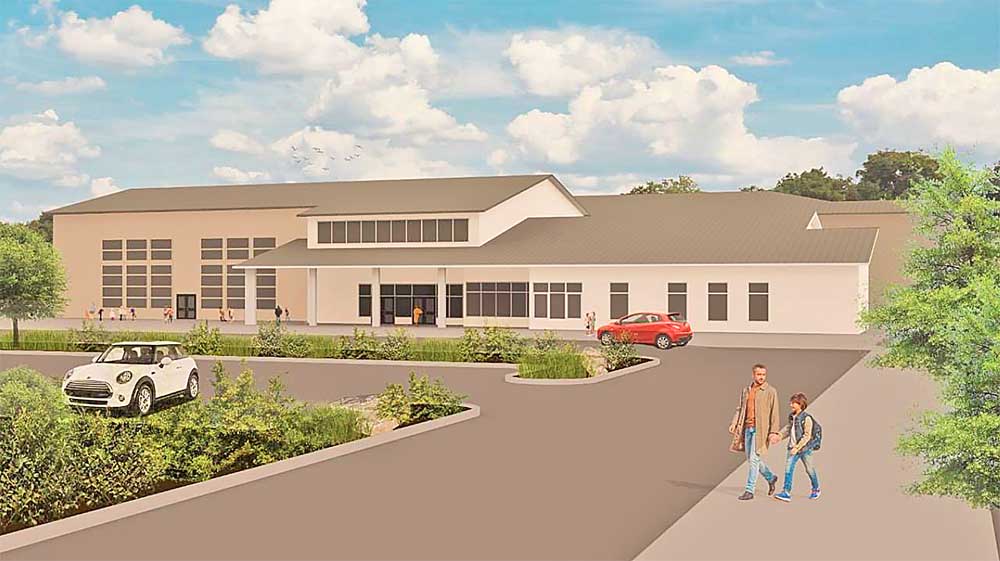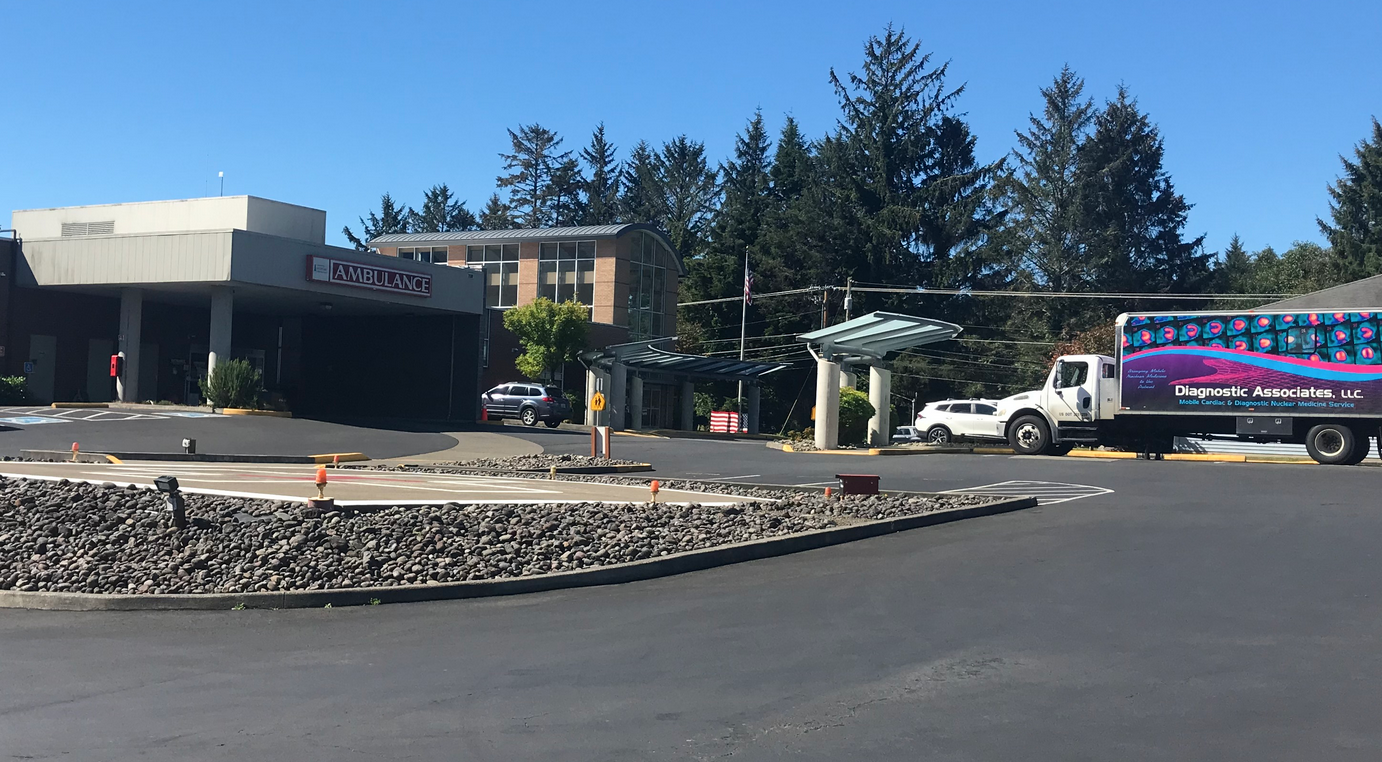School bond homework: Part 1
Published 4:37 pm Monday, November 22, 2021

- In a plan being discussed in Ocean Beach School District, a new unified elementary school, seen above in a very preliminary artist’s rendering, would be built on tsunami-safe ground in Ilwaco near the existing Hilltop Middle School. This building would replace separate grade schools in Ocean Park and Long Beach.
ILWACO — A diverse and expansive array of community stakeholders up and down the Long Beach Peninsula met inside the Ilwaco High School cafeteria for three hours last Wednesday night. The reason? To discuss the options and path ahead for a potential facilities bond vote as early as next spring.
Trending
The meeting was the latest development in a process that the Ocean Beach School District began this past spring to try and tackle how the district should address aging facilities and heightened concerns about two of its schools that are located in tsunami inundation zones. With the 20-year bond that voters passed in 2003 coming off the books soon, the district believes now could be the right time to move forward.
Along with OBSD administrative staff and school board members, the meeting was attended by members of the Facilities Advisory Committee. The committee was formed by OBSD earlier this year with the purpose of forming a group that represents the various pockets of the peninsula community and who can provide feedback and ask questions throughout the planning process and, ultimately, make a recommendation to the school board on the best path forward for the district’s facilities.
Diverse stakeholders
The committee, OBSD Superintendent Amy Huntley said, spans a number of spectrums: politically, geographically, community involvement and their connection to the school district, to name a few. Some members have no direct connection to OBSD at the moment, Huntley said, while others have children enrolled in the district.
“The goal of the committee is to look at our facilities, their strengths and their weaknesses, and really help us prioritize what our plan should be, facilities-wise, moving forward,” Huntley told the Observer. “We want the committee to talk to people, we want them communicating with the public … They aren’t the decision makers — the whole community decides things — but the representative group helps us narrow [the concepts] down.”
Among many others, those in attendance at Wednesday’s meeting included: David Glasson, Long Beach City Administrator; Claire Bruncke, executive director of the Dylan Jude Harrell Kids & Community Center; Lisa Kaino, natural resources specialist at the Washington State DNR; Madeline Matson, executive director of the Columbia-Pacific Heritage Museum; Matt Lessnau, Ilwaco City Councilor; Bonnie Lou Cozby, president of the Ocean Park Area Chamber of Commerce and the Ocean Park Village Club; and Bret Hopkins, WDFW officer and IHS head baseball coach.
OBSD officials reiterated to the FAC members that the scenarios being presented to them at the meeting were conceptual and by no means final products.
“This group is here to represent our community as a whole, and hopefully after today we’ll be able to come back and rework some things in a later meeting,” OBSD board member Tiffany Turner told the committee. “I think the whole idea is that [the district is] here to inform you of something, but really to listen to you and get feedback and get ideas in hopes that we really can come up with a concept that we can take to the board as a committee.”
If the committee ultimately makes a recommendation to the school board to move ahead with a bond vote for any of the suggestions presented to them, Huntley said the absolute earliest a bond vote would be held would be next April.
The first part of this two-part story focuses on concepts presented at the meeting that pertained to the future of the district’s elementary schools. The second part, to run in next week’s Observer issue, touches on potential upgrades to the high school and athletic facilities and the next steps in the district’s planning process.
Tsunami threat a key factor
The key focus of any potential upgrades to OBSD facilities, school officials said, would be centered around the health, safety and wellbeing of the district’s students and staff — particularly, safety from the threats posed by earthquakes and tsunamis.
As it stands, both of the district’s elementary schools, Long Beach Elementary (grades K-2) and Ocean Park Elementary (grades 3-5), are located in tsunami inundation zones.
Along with proposed remodeling and renovation work at the elementary schools — including replacing roofing, siding, windows and playground equipment — one possible avenue presented to FAC members at the meeting is to construct a vertical tsunami evacuation tower at each school. The tower at LBE would be located behind the school, and the OPE tower would be located across Pacific Way.
Vancouver-based architect Eric Lanciault, whom Huntley lauded as “practical,” was on hand to walk through each of the concepts presented at the meeting. In the case of the evacuation towers, each tower would be a minimum of 45 feet, in accordance with the latest maps from state agencies — although he acknowledged that the maps can and do change regularly.
The towers would be designed to hold 350 people each, and would be built with the intent of being specifically for students and staff to use, not the general public. It was noted that there have been some discussions with emergency management officials about a larger structure to accommodate the community at-large, if this is the concept that the committee recommends OBSD moves forward with.
“As I look at it, these are the best that can be done with a reasonable budget,” Lanciault said. “If we were to build a school today, we would design the whole ground-level to be breakaway [walls]. The cafeteria would be upstairs, the generators would be upstairs and it would be a fully functioning building for days and days.”
A member of the committee asked whether it would be possible for the towers to be used for another purpose, such as housing a gym, when it’s not being used to ride out the worst-case scenario. Lanciault indicated that it could be feasible.
Another FAC member asked if the towers being proposed have a proven track record in locations that have been hit by tsunamis in the past. Lanciault said only a limited number of towers exist in the United States, which obviously have yet to be put to use, but noted that Japan is the global leader in tsunami refugee structures and said theirs have withstood numerous tsunamis.
The campus concept
While the evacuation towers were the first potential option discussed by the committee, the concept that received far-and-away the most attention by district staff and FAC members at the meeting was the possibility of a three-school campus in Ilwaco. The campus would consist of the already-existing Hilltop Middle School and Ilwaco High School, as well as a new two-story K-5 elementary school that could house up to 660 students.
Under this concept, the number of school buildings in the district would be cut from four to three — which board member Don Zuern noted could be a long-term financial benefit with the district only needing to maintain three schools instead of four.
The campus option offers some clear benefits, not least of which is ensuring that all K-12 students and staff would be out of the tsunami inundation zone if disaster were to strike during school hours. Lanciault said the proposed location of the new elementary school, northeast of the middle school, and the campus as a whole, is “perfect”
“Unlike the tsunami towers, which have to be sunk so deep, this could be constructed like any other elementary school … It’s the perfect place to create a campus for safety, security and oversight, and to build a new school,” Lanciault said.
One of the FAC members noted that, as a parent, the campus option could be appealing for households with more than one child. Others said they would be reassured that each of the district’s schools would be a stone’s throw away from Ocean Beach Hospital under this scenario.
Cozby said that she was concerned about how well north and south end students would integrate under this concept, with all of the schools being located on the southern end of the peninsula.
“When we went through the whole reconfiguration process years ago, one of the biggest arguments for why we needed to split up the schools the way we did was the fact that kids from the north end have a hard time integrating into the south end,” Cozby said. “And now, we want to bring them all [to Ilwaco]?”
Huntley said Cozby’s concerns about north end students fitting in and being able to participate in athletics and after-school activities is something the district has discussed.
“Right now, [peninsula students in the same grade] are together from kindergarten on up, so [the campus plan] would be very similar to that and I don’t see any big change there,” Huntley said. She also pointed to the district’s activities bus, which provides after-school transportation for students who are participating in school-sanctioned sports and activities.
Huntley also noted that data from a few years ago shows that the median student lives just south of Sid Snyder Drive in Long Beach, although the pandemic could have reversed recent trends. “The kids have moved more south.”
Members of the committee also had questions about busing logistics under this scenario. Huntley said bus times to and from school would be more efficient and practical under the campus concept, with buses being able to pick up entire neighborhoods and utilize a shared campus bus loop.
To make room for the new elementary school in Ilwaco, the OBSD bus garage — already in need of a facelift, district officials said — would need to be relocated, with a new location behind the LBE building being mentioned as one possibility. If that concept comes to pass, the hope would be for the new bus garage to have three bays, covered fueling and above-ground fuel.
There was also some discussion about what to do with the unused LBE and OPE buildings if the campus concept became reality. Ideas that were floated during the meeting included having the LBE building house the district office and maintenance and technology departments, and possibly childcare, while the OPE building could be transformed into a community building. No firm recommendations were identified at this phase in the process, however, and FAC members cautioned against the district making any promises that they were not absolutely certain they could keep.
The second part of the two-part series about last Wednesday’s discussion will run in the Dec. 1 Observer issue.









